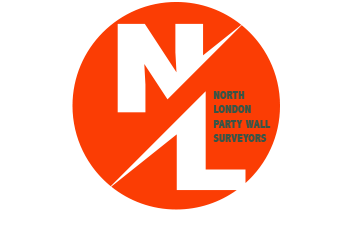“If you start work without having first given notice in the proper way, Adjoining Owners may seek to stop your work through a court injunction or seek other legal redress”.
– Department for Communities and Local Government, May 2016
What is a Party Wall?
The Act recognises two main types of Party Wall.
Party Wall – type 1: stands astride the boundary of land belonging to two (or more) different owners in one of the following different ways:
• Part of one building or
• Separates two (or more) buildings or
• A “party fence wall”, i.e. not part of a building, but stands astride the boundary line and is used to separate between lands of different owners (does not include wooden fences or hedges, etc).
Party Wall – type 2: stands wholly on one owner’s land, but is used by two (or more) owners to separate their buildings.
For example:
Where one building owner originally built a wall and a second owner constructed their building up against it without creating their own wall – enclosed on adjoining Owner’s wall after their consent. Only the part of the wall that physical separates is classified as “party” and not the sections on either side or above the wall.
What is the Party Wall etc. Act 1996?
The Party Wall, etc Act 1996 came into force on 1 July 1997 and applies throughout England and Wales, but does not apply to Scotland or Northern Ireland. It provides a framework for preventing or resolving disputes in relation to:
- Party walls
- Party structures
- Boundary walls
- Excavations near neighbouring buildings
Party Fence Walls
The Party Wall Act also cover “Party Fence Walls” which are deemed to be a wall of solid structure that sits astride a boundary and is not part of a building. Timber fencing, pre-cast concrete posts with infill panel fencing, are not considered to be a Party Fence Wall, whether astride a boundary or not.
How The Party Wall etc. Act 1996 works
Building Owners have a legal obligation to serve a formal Notice upon the Adjoining Owners, which detail the proposed works, which are notifiable under the Party Wall etc. Act 1996. Notice must be given even where the work will not extend beyond the centre line of a party wall. A party wall may not necessarily have a boundary running through its centre line for the whole of its length but for only part of its length.
IMPORTANT! The notice period is:
- TWO MONTHS – Under Section 2 (Party Structure Notices).
- ONE MONTH – Under Section 1 (Line of Junction) and Section 6 (Line of Excavation Notice).
A Notice will only be valid if it includes:
- Name and address of the building owner(s)
- Exact details of the proposed work
- Date when the work will begin
- An accompanying ‘cross-section’ foundation showing the depth of proposed excavation (under Section 6 only).
If the Adjoining Owners are satisfied that the Building Owners’ proposed works will not cause inconvenience or damage to their property, confirmation is given in writing that the Adjoining Owners consent to the works – and therefore, not provided with protection offered under the Party Wall. etc Act 1996. If, after a period of 14 days from serving of the Notice, the Adjoining Owner has not responded or has made known any concerns relating to the plans, a ‘dispute’ would then be deemed to have arisen.
The framework provided by the Party Wall etc. Act 1996 enables a resolution to be made, which allows the Building Owners to carry out works whilst providing protection to both parties. At the point when a “dispute” arises, both the Building Owners and the Adjoining Owners must appoint a Party Wall Surveyor to resolve the dispute, either via separate surveyor appointments or, by agreeing to a single surveyor, called the ‘Agreed Surveyor’.
What is a Party Wall Notice?
There are THREE types of Notice that a building owner may have to serve upon an adjoining owner to make them aware of the intention to carry out work which falls under the scope of the Act.
Party Structure Notice – Section 2 | Section 3
Party Structure Notices cover alterations directly affecting the party wall.
The most common work on existing party walls are to:
- Repair a party wall
- Cutting in flashings
- Insert a damp proof course
- Underpin the whole thickness of a party wall
- Cut holes to insert beams and padstones, e.g. in a loft conversion.
- Raise the height of a party wall, e.g. adding another storey.
- Extend a party wall downwards, e.g. to form a basement.
- Demolish and rebuild a party wall, e.g. if structurally defective.
- Underpin the whole thickness of a party wall, e.g. when building a basement.
- Cut off projections from a party wall or from an adjoining owner’s boundary | external wall if necessary.
- Remove a chimney breast.
Notice of Adjacent Excavation – Section 6
There are TWO types of excavations covered under a Notice of Adjacent Excavation:
- Excavating within 3 metres of a neighbour’s building, and to a depth lower than the foot of their foundations.
- Excavating within 6 metres of a neighbour’s building, if any part of that excavation cuts across a plane that is level with the face of their external wall, and drawn downwards at an angle of 45 degrees from the foot of their foundations.
The notice must contain the same information as a Party Structure Notice, and is accompanied by plans and sections showing the extent of the proposed excavation.
Line of Junction Notice – Section 1
This is the least common of the notices, which covers two separate constructions of a new wall:
- Adjacent to a boundary
- Astride – or ‘up against’ – a boundary.
The notice period is one month in which the adjoining owner can prevent building of a new wall astride the boundary. If the adjoining owner does not respond in writing within 14 days the building owner will have to build the new wall entirely on their side of the boundary line.
The Adjoining Owner must be compensated for any damage caused to their property as a result of building the wall, or the placing of footings and foundations under their land. There is no right to place “special foundations” under their land without written
What is a Party Wall Award?
The Party Wall Award – also known as the ‘Party Wall Agreement’ – is a legally-binding document, agreed by the appointed surveyors acting on behalf of the Building Owner(s) and Adjoining Owner (s), and consisting of three parts:
- The Award – a set of guidelines governing how the proposed works should progress in accordance with the Party Wall etc. Act 1996.
- ‘Schedule of Condition’ of the adjoining property, often supported by photographic evidence.
- Drawing(s) showing the details of the proposed works.
The Award clearly states the details of:
- The two properties, their owners and their owners’ addresses.
- The two surveyors (or ‘Agreed Surveyor’) and the ‘Third Surveyor’ (if an ‘Agreed Surveyor’ is not used).
Other details include:
- Working days and times.
- Measures required to protect the Adjoining Owners property from damage and unnecessary inconvenience.
- Provisions for making good or the payment of compensation should damage be caused.
- Access arrangement for the surveyors.
- Time limit for commencement of the works – usually 12 months.
What is a Party Wall?
The Act recognises two main types of Party Wall.
Party Wall – type 1: stands astride the boundary of land belonging to two (or more) different owners in one of the following different ways:
• Part of one building or
• Separates two (or more) buildings or
• A “party fence wall”, i.e. not part of a building, but stands astride the boundary line and is used to separate between lands of different owners (does not include wooden fences or hedges, etc).
Party Wall – type 2: stands wholly on one owner’s land, but is used by two (or more) owners to separate their buildings.
For example:
Where one building owner originally built a wall and a second owner constructed their building up against it without creating their own wall – enclosed on adjoining Owner’s wall after their consent. Only the part of the wall that physical separates is classified as “party” and not the sections on either side or above the wall.
What is the Party Wall etc. Act 1996?
The Party Wall, etc Act 1996 came into force on 1 July 1997 and applies throughout England and Wales, but does not apply to Scotland or Northern Ireland. It provides a framework for preventing or resolving disputes in relation to:
- Party walls
- Party structures
- Boundary walls
- Excavations near neighbouring buildings
Party Fence Walls
The Party Wall Act also cover “Party Fence Walls” which are deemed to be a wall of solid structure that sits astride a boundary and is not part of a building. Timber fencing, pre-cast concrete posts with infill panel fencing, are not considered to be a Party Fence Wall, whether astride a boundary or not.
How The Party Wall etc. Act 1996 works
Building Owners have a legal obligation to serve a formal Notice upon the Adjoining Owners, which detail the proposed works, which are notifiable under the Party Wall etc. Act 1996. Notice must be given even where the work will not extend beyond the centre line of a party wall. A party wall may not necessarily have a boundary running through its centre line for the whole of its length but for only part of its length.
IMPORTANT! The notice period is:
- TWO MONTHS – Under Section 2 (Party Structure Notices).
- ONE MONTH – Under Section 1 (Line of Junction) and Section 6 (Line of Excavation Notice).
A Notice will only be valid if it includes:
- Name and address of the building owner(s)
- Exact details of the proposed work
- Date when the work will begin
- An accompanying ‘cross-section’ foundation showing the depth of proposed excavation (under Section 6 only).
If the Adjoining Owners are satisfied that the Building Owners’ proposed works will not cause inconvenience or damage to their property, confirmation is given in writing that the Adjoining Owners consent to the works – and therefore, not provided with protection offered under the Party Wall. etc Act 1996. If, after a period of 14 days from serving of the Notice, the Adjoining Owner has not responded or has made known any concerns relating to the plans, a ‘dispute’ would then be deemed to have arisen.
The framework provided by the Party Wall etc. Act 1996 enables a resolution to be made, which allows the Building Owners to carry out works whilst providing protection to both parties. At the point when a “dispute” arises, both the Building Owners and the Adjoining Owners must appoint a Party Wall Surveyor to resolve the dispute, either via separate surveyor appointments or, by agreeing to a single surveyor, called the ‘Agreed Surveyor’.
Party Wall Notices
There are THREE types of Notice that a building owner may have to serve upon an adjoining owner to make them aware of the intention to carry out work which falls under the scope of the Act.
Party Structure Notice – Section 2 | Section 3
Party Structure Notices cover alterations directly affecting the party wall.
The most common work on existing party walls are to:
- Repair a party wall
- Cutting in flashings
- Insert a damp proof course
- Underpin the whole thickness of a party wall
- Cut holes to insert beams and padstones, e.g. in a loft conversion.
- Raise the height of a party wall, e.g. adding another storey.
- Extend a party wall downwards, e.g. to form a basement.
- Demolish and rebuild a party wall, e.g. if structurally defective.
- Underpin the whole thickness of a party wall, e.g. when building a basement.
- Cut off projections from a party wall or from an adjoining owner’s boundary | external wall if necessary.
- Remove a chimney breast.
Notice of Adjacent Excavation – Section 6
There are TWO types of excavations covered under a Notice of Adjacent Excavation:
- Excavating within 3 metres of a neighbour’s building, and to a depth lower than the foot of their foundations.
- Excavating within 6 metres of a neighbour’s building, if any part of that excavation cuts across a plane that is level with the face of their external wall, and drawn downwards at an angle of 45 degrees from the foot of their foundations.
The notice must contain the same information as a Party Structure Notice, and is accompanied by plans and sections showing the extent of the proposed excavation.
Line of Junction Notice – Section 1
This is the least common of the notices, which covers two separate constructions of a new wall:
- Adjacent to a boundary
- Astride – or ‘up against’ – a boundary.
The notice period is one month in which the adjoining owner can prevent building of a new wall astride the boundary. If the adjoining owner does not respond in writing within 14 days the building owner will have to build the new wall entirely on their side of the boundary line.
The Adjoining Owner must be compensated for any damage caused to their property as a result of building the wall, or the placing of footings and foundations under their land. There is no right to place “special foundations” under their land without written
What is a Party Wall Award?
The Party Wall Award – also known as the ‘Party Wall Agreement’ – is a legally-binding document, agreed by the appointed surveyors acting on behalf of the Building Owner(s) and Adjoining Owner (s), and consisting of three parts:
- The Award – a set of guidelines governing how the proposed works should progress in accordance with the Party Wall etc. Act 1996.
- ‘Schedule of Condition’ of the adjoining property, often supported by photographic evidence.
- Drawing(s) showing the details of the proposed works.
The Award clearly states the details of:
- The two properties, their owners and their owners’ addresses.
- The two surveyors (or ‘Agreed Surveyor’) and the ‘Third Surveyor’ (if an ‘Agreed Surveyor’ is not used).
Other details include:
- Working days and times.
- Measures required to protect the Adjoining Owners property from damage and unnecessary inconvenience.
- Provisions for making good or the payment of compensation should damage be caused.
- Access arrangement for the surveyors.
- Time limit for commencement of the works – usually 12 months.






